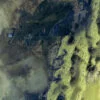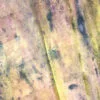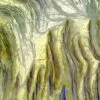The Archive was indefensible and security breaches were at an all-time high when a girl (six years old, and in every other respect quite ordinary – living with her extended family somewhere in the banlieues) was discovered with what could only be described as a ‘virtually limitless’ power of recall. With 200,000 years of accumulated knowledge at stake, there seemed no better solution than to rely, once again, upon the faculties of the human mind.
Of course, they had to admit from the outset the idea was flawed. That it was, at best, a ‘temporary measure’. But it was generally agreed – even by those scientists, historians, administrators and policymakers who (all bent on arriving, respectively, at a more sustainable solution) did not generally agree upon anything – that if properly educated, this remarkable young girl might buy them all a little valuable time.
A rigorous and fully funded education programme was quickly provided by the state, employing a team of researchers from every imaginable field. The ‘Masters’, as the team of thirty-seven came to be known, instructed the girl in every stage of the development of human thought covering every topic, every method, every (often conflicting) angle and approach to science, art, technology, trade and history itself over the past 200,000 years. The girl’s appetite for knowledge proved so voracious that by the time she was nine years old her ‘memory’ extended back to the beginnings of human life on Earth. By eleven, she could remember rising from the mud; by twelve – with a reflexive shudder – the moment the first unicellular structure divided into two; by fourteen (and in not only accurate but moving detail) she could describe the conflicting pressures of gravity and time that caused the Earth to strain and shift, that set the continents adrift and gave birth to mountain ranges, ocean beds, polar ice and magnetic fields.
The fact that the girl was – aside from her extraordinary memory – really quite ordinary was not at first considered a disadvantage. She’d been removed from her extended family shortly after her genius was discovered – her only influences the thirty-seven Masters – but throughout she continued to demonstrate the usual range of human emotion, both delighting and confounding her Masters with bursts of frank affection, unreasonable anger and unexplained joy.
The programme had been named Whirlwind III after the first real-time computer system to benefit from the invention of core memory, but not only (the Masters boasted) did the girl already possess more core memory than any computer operating system that had been designed, she was also adaptable, fiercely loyal and unusually empathetic – three things still lacking from every other system of record-keeping, including the most advanced forms of AI.
As the girl grew older, however, her passions became less predictable, as well as less easy to temper. During an especially volatile moment at age fourteen, she even threatened to end her own life. (‘What do I care?’ she shrieked at the Masters. ‘They’re your memories – not mine!’) The Masters did what they could to hush up the incident, but, inevitably, word got out – and the backlash was fierce. Up until this point, the programme had received wide and popular support; millions had happily followed the education and development of the bright-eyed, red-cheeked ‘Rememberer’ in the tabloids and the weekly news, but now nearly everyone began to complain. It was obvious (many early critics of the programme warned) that the burden of 200,000 years of accumulated knowledge was too much for any human being. It was inhumane – another especially vocal group argued – to invest ‘the full range of human experience’ in a single child precisely because it prevented her from actually participating in ‘the full range of human experience’. No wonder the girl was increasingly troubled by insomnia and alternated between fits of rage and despair! No wonder that she had threatened to end her own life – and with it every possibility of establishing a more permanent record! No wonder that – shortly after, when she turned sixteen – she began to suffer from brief, inexplicable flashes of ‘darkness’! (Petit mal seizures, the neurologists called them – but, upon further examination, no physical or biochemical cause could be found for the episodes and it was concluded that ‘nothing’ was wrong.)
The Masters fought among themselves, each one blaming another for the girl’s emotional volatility and her ‘absences’, which (despite the doctors’ prognosis) continued with increasing frequency. Each time they occurred – without explanation or warning – the girl would be unable to speak and, for several terrifying seconds, her face would go blank. Each time, 200,000 years of accumulated knowledge would flash horribly before the Masters’ eyes.
And it was no wonder. Ten years had passed since the programme began, but still those (scientists, historians, administrators and policymakers alike) dedicated to arriving at a more permanent solution were no closer to finding one. The girl remained their only hope . . . and yet the situation was hopeless. The public still spoke out from time to time, but as they began to lose interest, it was the girl herself who became the programme’s toughest critic – describing its limitations as ‘insurmountable’ and ‘systemic’, uniquely tied not only to the limits and vagaries of her education, but also to her own mind.
What should trouble them most, she protested, was that she was unable to pinpoint where one memory left off from another – or where they began. Rather than a continuous, chronological archive, her memories were instead fragmented, scattered, often vague. They would surface strangely, like photographs in a chemical bath – transformed into negative images of themselves. But rather than – like a photograph – indexing any actual experience, they seemed instead to mark a void.
And what (she demanded one day – chin jutted, eyes sharp and hard; the very ‘picture’ of adolescent impudence) of memories that could not be indexed at all? That were instead mere whiffs of sensations, brief bursts of colour, a feeling of being pricked by something – of ‘going under’, as beneath a sudden wave? What in fact were those memories, or any others (in which, say, she scoured the depths of the first oceans, or awakened in the mind of a cephalopod as the simple contrast between darkness and light), if not the products of someone else’s imagination? What she ‘remembered’ was in any case not knowledge. It was speculation, conjecture . . . It was the purest of fictions!
In other moods, she would grumble that she ‘hardly saw the point’. The history of human thought, she would sigh despairingly, was nothing more, after all, than an arduous dream. In still other moods, she would become fierce, aloof. Only to brighten a moment later, laugh out loud, or surprise someone with a firm embrace.
Emotional turbulence was, of course (the Masters reasoned), an unavoidable side effect to the girl’s demanding course of study. What else could they expect from a young woman capable of grasping – simultaneously – both Cantor’s continuum hypothesis and mathematical Platonism? Or of recalling – in excruciating detail – what it felt like to die in battle both as, for example, a proud defender of the Orange Free State and as a Basotho child? It was for this reason, after all, that the human mind had evolved to remember only selectively. For this reason that experience became symbolic, then relative, that memories receded, that they sometimes altogether disappeared. Forgetting was as simple a defence mechanism as sex, or flight, the evolution of which (as the girl concurred) could be traced back to the very origin of the species . . .


Sign in to Granta.com.








